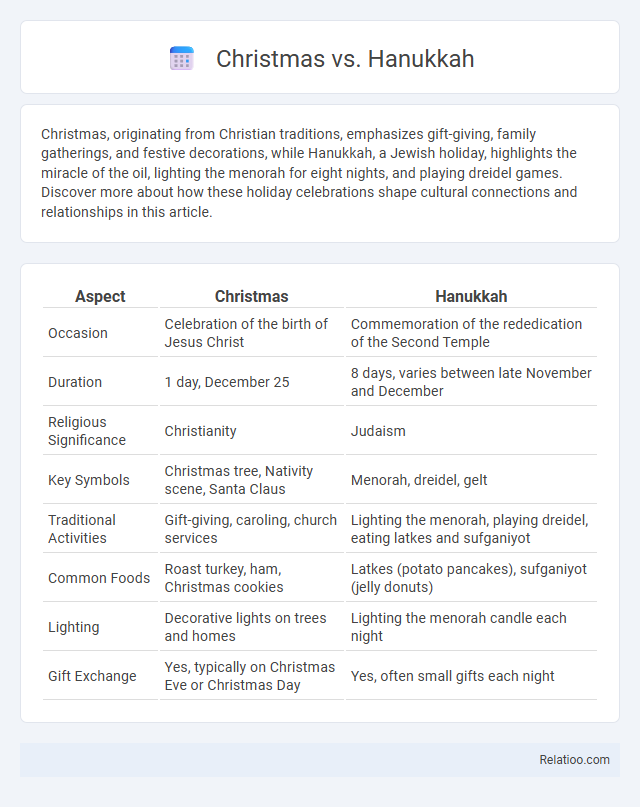Christmas, originating from Christian traditions, emphasizes gift-giving, family gatherings, and festive decorations, while Hanukkah, a Jewish holiday, highlights the miracle of the oil, lighting the menorah for eight nights, and playing dreidel games. Discover more about how these holiday celebrations shape cultural connections and relationships in this article.
Table of Comparison
| Aspect | Christmas | Hanukkah |
|---|---|---|
| Occasion | Celebration of the birth of Jesus Christ | Commemoration of the rededication of the Second Temple |
| Duration | 1 day, December 25 | 8 days, varies between late November and December |
| Religious Significance | Christianity | Judaism |
| Key Symbols | Christmas tree, Nativity scene, Santa Claus | Menorah, dreidel, gelt |
| Traditional Activities | Gift-giving, caroling, church services | Lighting the menorah, playing dreidel, eating latkes and sufganiyot |
| Common Foods | Roast turkey, ham, Christmas cookies | Latkes (potato pancakes), sufganiyot (jelly donuts) |
| Lighting | Decorative lights on trees and homes | Lighting the menorah candle each night |
| Gift Exchange | Yes, typically on Christmas Eve or Christmas Day | Yes, often small gifts each night |
Origins and Historical Background
Christmas originates from the celebration of the birth of Jesus Christ, rooted in Christian traditions dating back to the 4th century, while Hanukkah commemorates the rededication of the Second Temple in Jerusalem around 165 BCE after the Maccabean Revolt. Your understanding of these holidays benefits from recognizing Christmas' link to Roman winter festivals and Hanukkah's foundation in Jewish resistance and miracle symbolism. Both holidays use distinct symbols: Christmas employs the Christmas tree and nativity scenes, whereas Hanukkah is marked by the menorah and the miracle of oil lasting eight days.
Core Beliefs and Religious Significance
Christmas centers on the birth of Jesus Christ, symbolizing hope and salvation in Christian faith. Hanukkah commemorates the rededication of the Second Temple and the miracle of the oil, emphasizing resilience and divine intervention in Judaism. Understanding these core beliefs helps you appreciate the distinct religious significance and rich symbolism behind each holiday.
Key Symbols and Iconography
Christmas is symbolized by the evergreen Christmas tree, nativity scenes, and the star representing the Star of Bethlehem, while Hanukkah centers around the menorah, specifically the nine-branched Hanukkiah, symbolizing the miracle of the oil lasting eight days. The Christmas wreath, holly, and mistletoe are also rich in Christian symbolism, representing eternal life and love. Your understanding of these holidays deepens by recognizing how these key symbols and iconography uniquely convey traditions and spiritual narratives.
Rituals and Traditions
Christmas rituals center on decorating Christmas trees, exchanging gifts, and attending midnight church services, symbolizing the birth of Jesus Christ. Hanukkah traditions include lighting the menorah for eight nights, playing dreidel games, and eating foods fried in oil, commemorating the rededication of the Second Temple and the miracle of the oil. Your celebration experience is enriched by understanding the symbolism behind each ritual, highlighting themes of light, faith, and miracle in both holidays.
Duration and Timing of Celebrations
Christmas is celebrated annually on December 25th, lasting for one day but often extended into a festive season spanning late November through early January. Hanukkah spans eight days and nights, typically falling between late November and December, with the exact timing determined by the Hebrew calendar. These differing durations and timings highlight the unique cultural and religious symbolism of light and renewal central to each holiday's observance.
Food and Festive Cuisine
Christmas features iconic dishes like roast turkey, ham, and gingerbread cookies that embody festive warmth and tradition. Hanukkah centers on symbolic foods such as latkes (potato pancakes) and sufganiyot (jelly-filled doughnuts), both fried to represent the miracle of the oil. Your holiday table can highlight these distinctive cuisines, enriching the celebration with meaningful tastes and cultural symbolism.
Gift-Giving Customs
Christmas gift-giving customs center around exchanging presents to celebrate generosity and the spirit of Saint Nicholas, often featuring wrapped gifts under a decorated tree. Hanukkah gift traditions emphasize giving small presents or gelt, symbolizing light and hope during the Festival of Lights, rooted in Jewish history and religious values. Both holidays use gift-giving as a means to express love and joy but differ in historical significance and symbolic meaning.
Music and Cultural Expressions
Christmas music features classic carols like "Silent Night" and "Jingle Bells," emphasizing themes of joy, peace, and the birth of Jesus Christ, while Hanukkah music highlights traditional Hebrew songs such as "Maoz Tzur" that celebrate the rededication of the Second Temple and Jewish resilience. Cultural expressions during Christmas often include nativity plays, Christmas markets, and festive decorations symbolizing light and salvation, whereas Hanukkah is marked by lighting the menorah, playing dreidel games, and sharing foods like latkes, symbolizing perseverance and divine miracles. Both holidays use music and customs to reinforce communal identity and spiritual meaning, reflecting deep-rooted historical and religious significance within their respective cultures.
Decorations and Lighting Practices
Christmas decorations often feature colorful lights, wreaths, and Christmas trees symbolizing joy and festivity, while Hanukkah lighting centers on the menorah, with each candle representing a night of the eight-day celebration commemorating the miracle of the oil. Your holiday decor can reflect deep cultural symbolism, incorporating bright, twinkling lights and symbols like stars for Christmas or the shamash candle for Hanukkah, enhancing the spiritual atmosphere. Both traditions emphasize illumination as a form of hope and renewal, using lighting practices to create warmth and connection during the winter season.
Modern-Day Observances and Inclusivity
Modern-day observances of Christmas and Hanukkah reflect diverse cultural practices that emphasize inclusivity and shared values. Christmas celebrations often incorporate symbols like the Christmas tree and gift-giving, highlighting themes of generosity and family unity, while Hanukkah features the menorah and dreidel, symbolizing resilience and religious freedom. Both holidays embrace inclusivity by inviting participation across different communities, fostering interfaith understanding and respect for cultural heritage.

Infographic: Christmas vs Hanukkah
 relatioo.com
relatioo.com